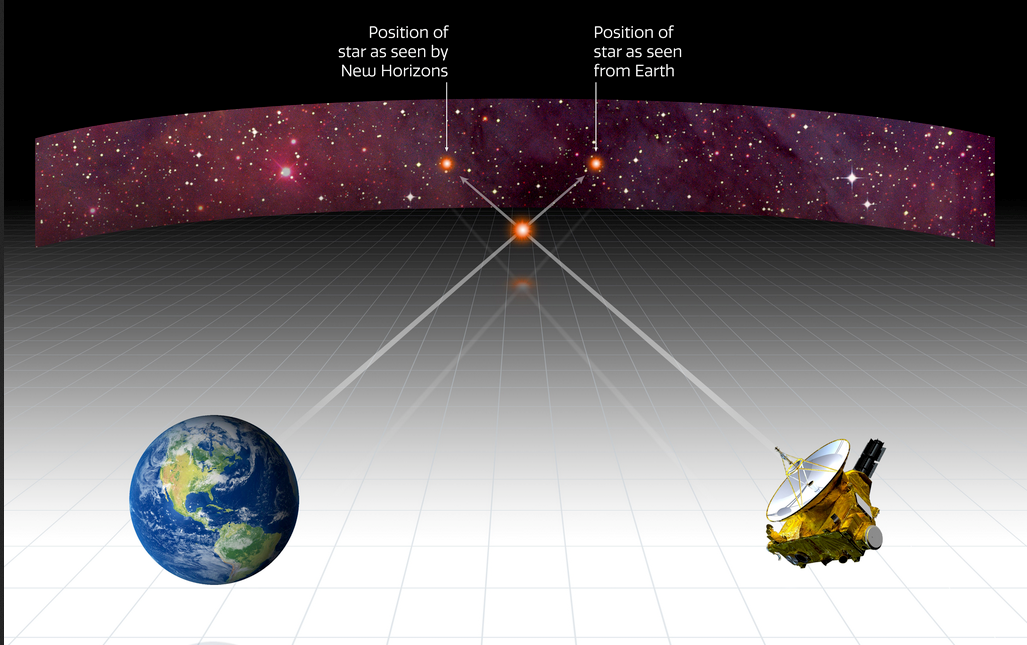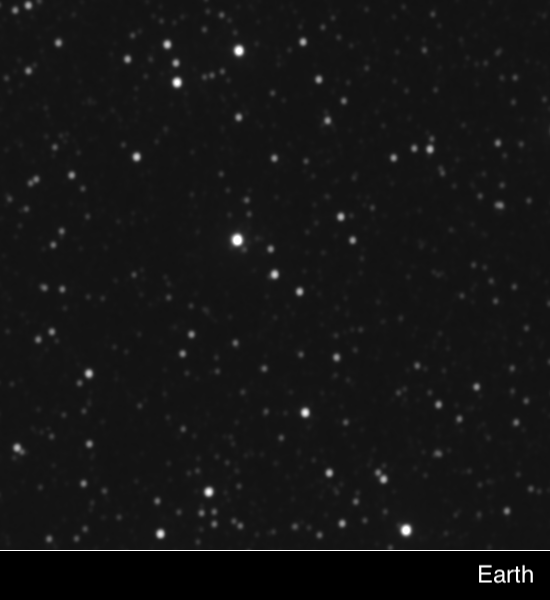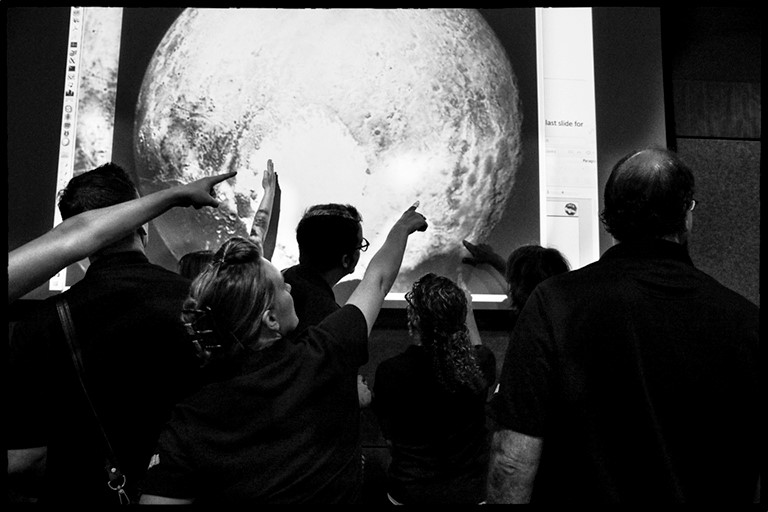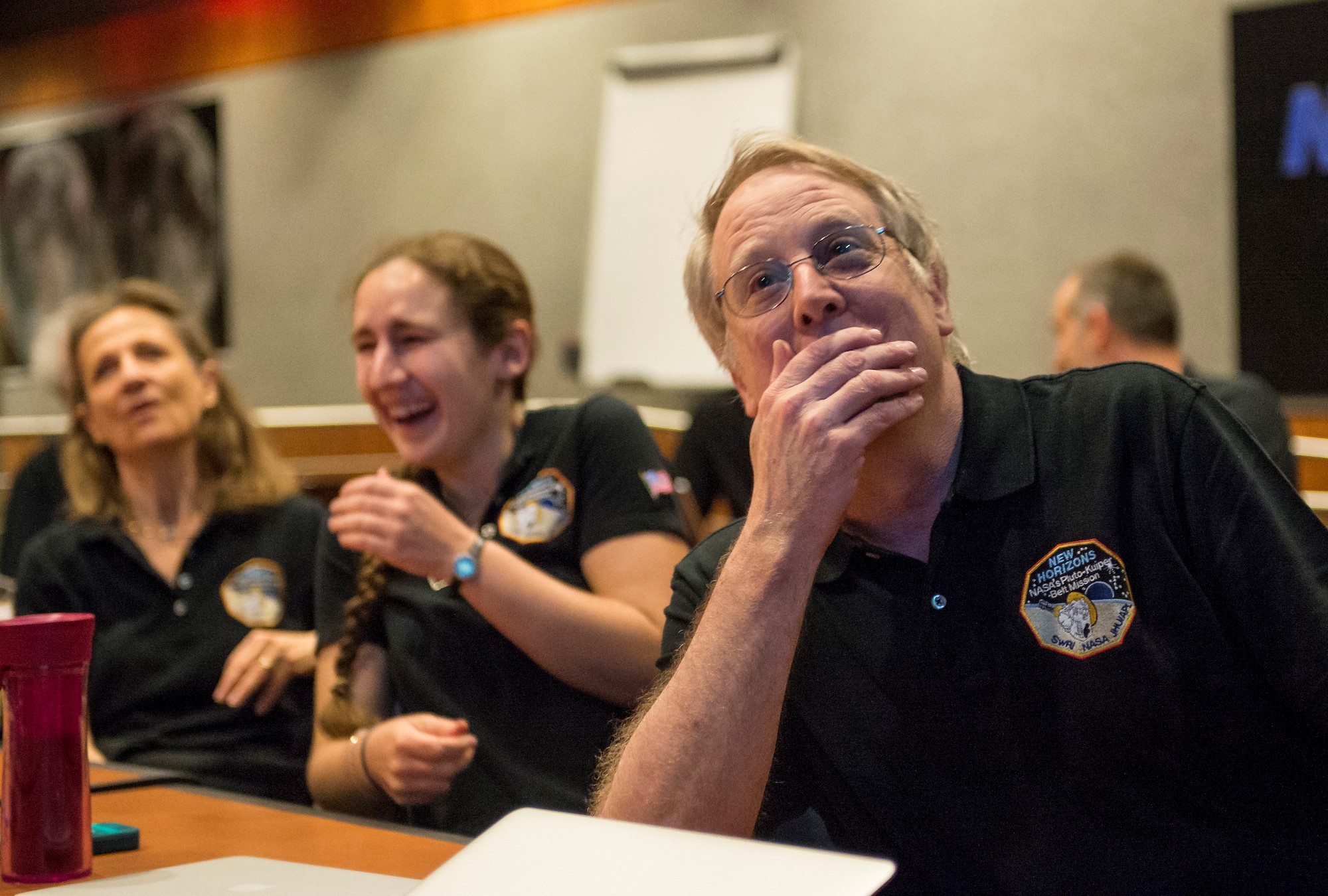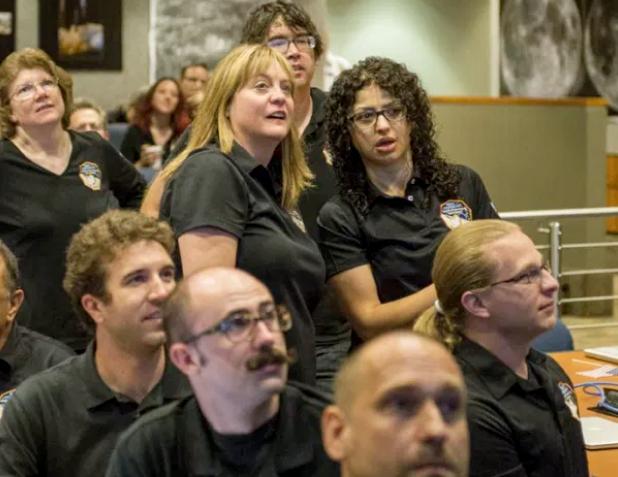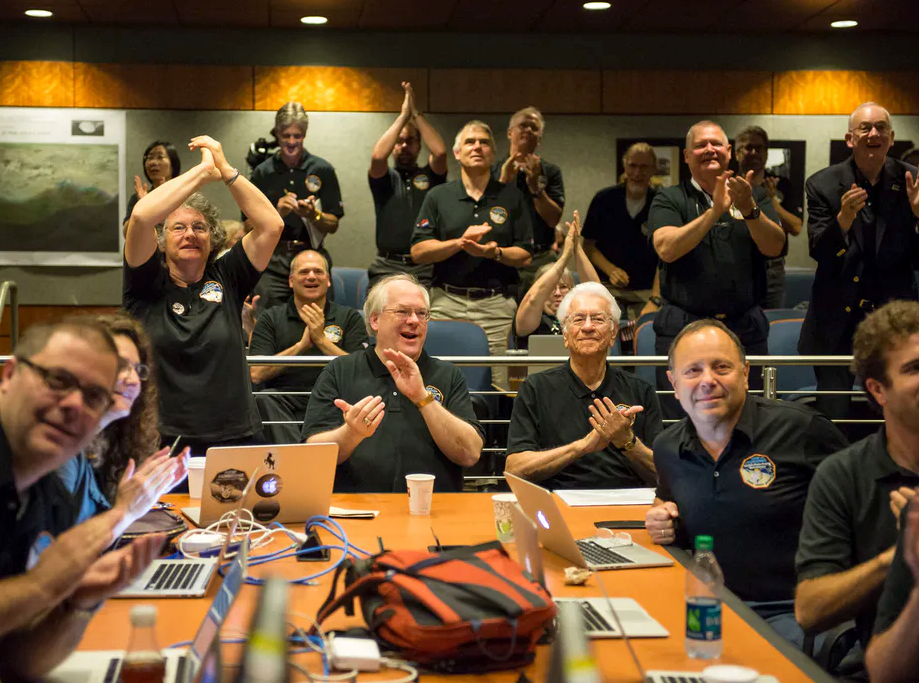16.07.2020
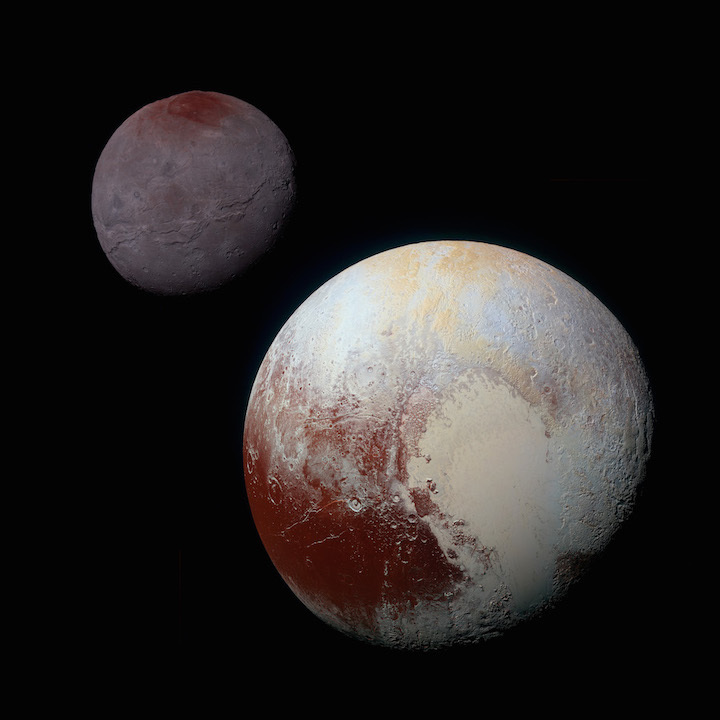
Five years ago, NASA’s New Horizons spacecraft barreled by Pluto for a high-speed encounter that gave humanity its first fleeting close-up look at the distant world, finding glaciers and mountains of water ice. Scientists are now planning how to go back.
New Horizons flew within 7,800 miles (12,550 kilometers) of Pluto on July 14, 2015, more than nine years after departing Earth on a speedy trajectory that made the spacecraft the fastest ever launched up to that time.
The mission snapped numerous images, revealing unexpected geologic activity on Pluto, craggy mountain ranges made of hardened water ice, dune fields containing frozen methane, the largest glacier in the solar system.
The New Horizons mission is the first to visit the the Kuiper Belt, a ring of small, icy worlds beyond the orbit of Neptune. After zooming past Pluto, the largest world in the Kuiper Belt, the plutonium-powered spacecraft journeyed farther from the sun and flew by a peanut-shaped object named Arrokoth on Jan. 1, 2019.
Arrokoth is a billion miles beyond Pluto, and scientists say evidence suggests the two lobes that make up the 22-mile-long (36-kilometer) object likely formed near one another soon after the birth of the solar system 4.5 billion years ago, then merged together at a relatively slow relative velocity. That would make Arrokoth a primordial world that likely has remain unchanged for billions of years.
New Horizons continues deeper into the outer solar system, conducting long-range observations of other objects in the Kuiper Belt and measuring the behavior of the solar wind at ever-farther distances from the sun.
“I think the solar system literally saved the best for last with Pluto,” wrote Alan Stern, principal investigator for NASA’s New Horizons mission. Of course, I’m a little biased — as we all are on New Horizons — but I can’t think of a more beautiful and scientifically richer way to have completed the first era of the reconnaissance of the planets, which NASA started in 1962 with the first visit to any planet – Venus.”
In a matter of a few hours, New Horizons gathered sharp views of Pluto’s mountains and apparent ice flows, observed its tenuous atmosphere, and imaged Pluto’s five moons, including its largest companion Charon.
“It took 16 months to transmit all the Pluto system data back, but by late 2016, the entire haul of precious data was here on Earth,” Stern wrote. “Now, after five years of work to analyze those data, our appreciation and understanding of Pluto and its moons just continues to multiply.”

Data beamed back by New Horizons indicated Pluto likely harbors a subsurface ocean of liquid water, a highly unexpected discovery. A glacier-filled basin named Sputnik Planitia contained icy “cells” that appear to be turning over in a process called convection, evidence that parts of the Pluto’s surface are being regenerated through active geologic processes.
New Horizons also discovered two mountain peaks on Pluto that have deep central pits. They may be signs that volcanoes have erupted on Pluto, but instead of spewing out hot lava, they would have likely discharged slushy, viscous cryoflows of water.
But New Horizons only got a quick look at Pluto, and scientists are eager to send another mission to orbit the distant world. Such a mission would cost billions of dollars, and NASA is awaiting a recommendation from the National Academies of Sciences, Engineering, and Medicine on what robotic planetary missions the agency should begin developing in the next decade.
The National Academies’ planetary decadal survey is expected to produce its report in 2022. NASA’s policy is to follow the decadal survey’s recommendations on which flagship-class planetary science missions the agency should pursue next.
The top two priorities in the last planetary decadal survey report, released in 2011, were a Mars Sample Return mission to collect samples for return to Earth, and an orbiter to visit Jupiter’s icy moon Europa. Those concepts evolved to become NASA’s Perseverance rover, scheduled for launch later this month, to gather the Martian samples, followed by joint U.S.-European missions launching later in 2020s to bring the specimens back to Earth.
The Europa mission concept eventually became the Europa Clipper mission, which NASA is developing for launch as soon as 2024.
NASA has funded 11 planetary mission concept studies for consideration by the next decadal survey panel. The list includes a robotic lander to Mercury, a flagship Venus mission, a network of probes to study the moon’s geology, a long-lived lunar rover that could drive more than 1,000 miles across the moon’s surface, and missions to Mars, asteroids, Saturn’s moon Enceladus, Neptune and its moon Triton, and Pluto.
Carly Howett, a member of the New Horizons science team from the Southwest Research Institute, led the concept study for a potential orbiter that could fly to Pluto. With an estimated cost of $3 billion — not including launch expenses — the mission concept has been named Persephone, wife of Pluto and queen of the underworld in classical mythology.
“We want to go back and explore the Pluto system and the Kuiper Belt,” Howett said June 1 in a presentation to NASA’s Small Bodies Assessment Group, a community of scientists with research interests in asteroids, comets and the Kuiper Belt. “Of course, New Horizons did a great job of exploring the Pluto system in 2015, and I was on that mission … but it was just a single encounter.”
An orbiter would see more of Pluto than New Horizons, and would be able to track changes on Pluto’s surface and in its atmosphere over time.

The biggest challenge in developing a mission to orbit Pluto is getting there, Howett said.
“A lot of the work that we did was looking at the trajectories, and how we get there,” she said in a presentation of the Persephone mission concept study May 27. “Most of the instrumentation has already been used … So a lot of our processing and a lot of our time was spent looking at how to get there and how to operate.”
New Horizons was a flyby mission, so it didn’t need to slow down when it reached Pluto. In order to slip into orbit, a spacecraft will need to reduce its velocity enough to allow Pluto’s gravity to capture it.
That requirement means a Pluto orbiter, like the Persephone concept, will have to fly at a slower speed than New Horizons, which took more than nine years to reach Pluto.
“Trying to get into the Pluto system at sort of the quickest time available is a difficult problem,” Howett said June 1. “Because Pluto is a long way away, you want to get there quickly, which means going fast. But the faster you go, the more you have to slow down … So there’s this tradeoff between how you launch and how quickly you go versus how quickly you need to slow down.”
The Persephone concept outlined by Howett’s team, which included scientists from several universities and research institutions, would carry up to 11 science instruments and a large tank of xenon fuel for an electric propulsion system. The plasma thrusters, which are more efficient than conventional rocket engines, would allow the spacecraft to more efficiently brake into orbit around Pluto, then adjust its trajectory around Pluto and its moons for at least three years of scientific observations.
The plasma thrusters would also allow the spacecraft to fly by a Kuiper Belt Object on the way to Pluto, and potentially depart Pluto to visit another target in an extended mission, Howett said.
The high power demand of a complex suite of cameras, a radar, spectrometers and other sensors — plus the electric propulsion system — will outpace the power requirements of any robotic deep space mission to date. While New Horizons carried a single power generator fueled by plutonium — called an RTG — a mission like Persephone would need four or five plutonium generators, according to Howett.
Pluto is too far from the sun to allow a spacecraft to produce electricity with solar panels.
“This is a huge spacecraft,” Howett said.
The easiest way to fly a probe to Pluto is to use the strong gravity of Jupiter, the solar system’s largest planet, to slingshot the spacecraft into the outer solar system. The New Horizons mission used such a “gravity assist” maneuver with Jupiter, and a future Pluto orbiter will likely swing by Jupiter, too.
That means mission planners will have to factor in Jupiter’s position relative to Earth and Pluto. After 2032, Jupiter moves into a more unfavorable alignment.
“Fundamentally, it means that in order to get to the Pluto system in under 20 years you need to launch before 2032,” Howett said.
If the mission took off during the next launch opportunity in 2033, it would take nearly 30 years to reach Pluto. Travel times would only approach 20 years again in the 2040s, according to a chart presented by Howett.
“You have to wait about a decade before Jupiter comes into phase enough that you can get there on the order of sort of 20-to-25 years,” she said. “So in order to get to the Pluto system, you really need to launch before 2032, otherwise there’s this 10-year time of flight penalty.”

What’s more, those lengthy travel times assume the Pluto orbiter launches on a huge rocket. Howett said the spacecraft concept from the Persephone study would require a launch on a new version NASA’s Space Launch System with an enlarged upper stage and evolved strap-on boosters, a configuration NASA calls the SLS Block 2.
The first SLS test flight, using a more basic configuration, is currently scheduled in the second half of 2021. An SLS with the enlarged four-engine upper stage could debut a few years later, but the SLS Block 2 with evolved boosters is not expected to fly until the end of the 2020s, at the earliest.
And even the SLS Block 2 couldn’t do the trick by itself. A high-energy upper stage, like United Launch Alliance’s Centaur stage, mounted on top of the launch vehicle would need to give the Pluto orbiter an additional boost.
“We need the kind of the oomph of an SLS Block 2, with a Centaur kick stage,” Howett said. “That’s basically the biggest rocket we can fly with the biggest kick stage we can find.”
Quelle: SN
----
Update: 19.07.2020
.
Five Years after New Horizons' Historic Flyby, Here Are 10 Cool Things We've Learned About Pluto
Five years ago today, NASA's New Horizons spacecraft made history. After a voyage of nearly 10 years and more than 3 billion miles, the intrepid piano-sized probe flew within 7,800 miles of Pluto. For the first time ever, we saw the surface of this distant world in spectacular, colored detail.
The encounter – which also included a detailed look at the largest of Pluto's five moons, Charon -- capped the initial reconnaissance of the planets started by NASA's Mariner 2 mission more than 50 years before, and revealed an icy world replete in magnificent landscapes and geology — towering mountains, giant ice sheets, pits, scarps, valleys and terrains seen nowhere else in the solar system.
And that was only the beginning.
In the five years since that groundbreaking flyby, nearly every conjecture about Pluto possibly being an inert ball of ice has been thrown out the window or flipped on its head.
It's clear to me that the solar system saved the best for last! We could not have explored a more fascinating or scientifically important planet at the edge of our solar system. The New Horizons team worked for 15 years to plan and execute this flyby and Pluto paid us back in spades!
Alan Stern, New Horizons principal investigator from the Southwest Research Institute, Boulder, Colorado
Scientists now know that, despite it being literally out in the cold, Pluto is an exciting, active and scientifically valuable world. Incredibly, it even holds some of the keys to better understand the other small planets in the far reaches of our solar system.
Enhanced color global view of Pluto, taken when NASA's New Horizons spacecraft was 280,000 miles (450,000 kilometers) away. (Credit: NASA/Johns Hopkins APL/Southwest Research Institute)
Here are 10 of the coolest, weirdest and most unexpected findings about the Pluto system that scientists have learned since 2015, thanks to data from New Horizons.
Sometimes you just have to follow your heart, and Pluto seems to have taken that advice quite literally.
Pluto's heart – one of the signature features New Horizons observed on approach and imaged in high resolution during the flyby -- is a vast, million-square-mile nitrogen glacier. The heart's left ventricle, called Sputnik Planitia, literally forced the dwarf planet to reorient itself so the basin now faces almost squarely opposite Pluto's moon Charon.
"It's a process called true polar wander — it's when a planetary body changes its spin axis, usually in response to large geologic processes," said James Tuttle Keane, a planetary scientist and New Horizons team member at the Jet Propulsion Laboratory in Pasadena, California.
Sputnik Planitia's current position is no accident. It's a cold trap, where nitrogen ices have accumulated to make an ice sheet that's at least 2.5 miles (4 kilometers) thick. The constant imbalance of that hefty mass, combined with the tidal yanks and pulls of Charon as it orbited Pluto, literally tipped the dwarf planet so the basin aligned more closely with the tidal axis between Pluto and Charon.
"That event was also likely responsible for cracking Pluto's surface and creating the many gigantic faults in its crust that zigzag over large portions of Pluto," Keane said.
The basin is thought to have formed to the northwest of its present location, and closer to Pluto's north pole. And should ices continue to accumulate on the basin, Pluto will continue to reorient itself.

Natural-color view of Pluto and its large moon Charon, compiled from images taken by NASA's New Horizons spacecraft on July 13 and 14, 2015. (Credit: NASA/Johns Hopkins APL/Southwest Research Institute)
But there's more to that story...
Gathered ices may not be the only thing that helped reorient Sputnik Planitia. New Horizons data from the basin indicated there may be a heavier mass beneath it that played a part, and scientists suspect that the heavier mass is a water ocean.
That was an astonishing discovery. It would make Pluto an elusive 'ocean world,' in the same vein as Europa, Enceladus and Titan.
James Tuttle Keane, a planetary scientist and New Horizons team member at the Jet Propulsion Laboratory in Pasadena, California
Several other lines of evidence, including tectonic structures seen in New Horizons imagery, also point to an ocean beneath Pluto's crust.
Sputnik Planitia was likely created some 4 billion years ago by the impact of a Kuiper Belt object 30 to 60 miles (50 to 100 kilometers) across that carved out a massive chunk of Pluto's icy crust and left only a thin, weak layer at the basin's floor. A subsurface ocean likely intruded the basin from below by pushing up against the weakened crust, and later the thick layer of nitrogen ice seen there now was laid on top.
Recent models based on images of the planet suggest that this liquid ocean may have arisen from a rapid, violent formation of Pluto.
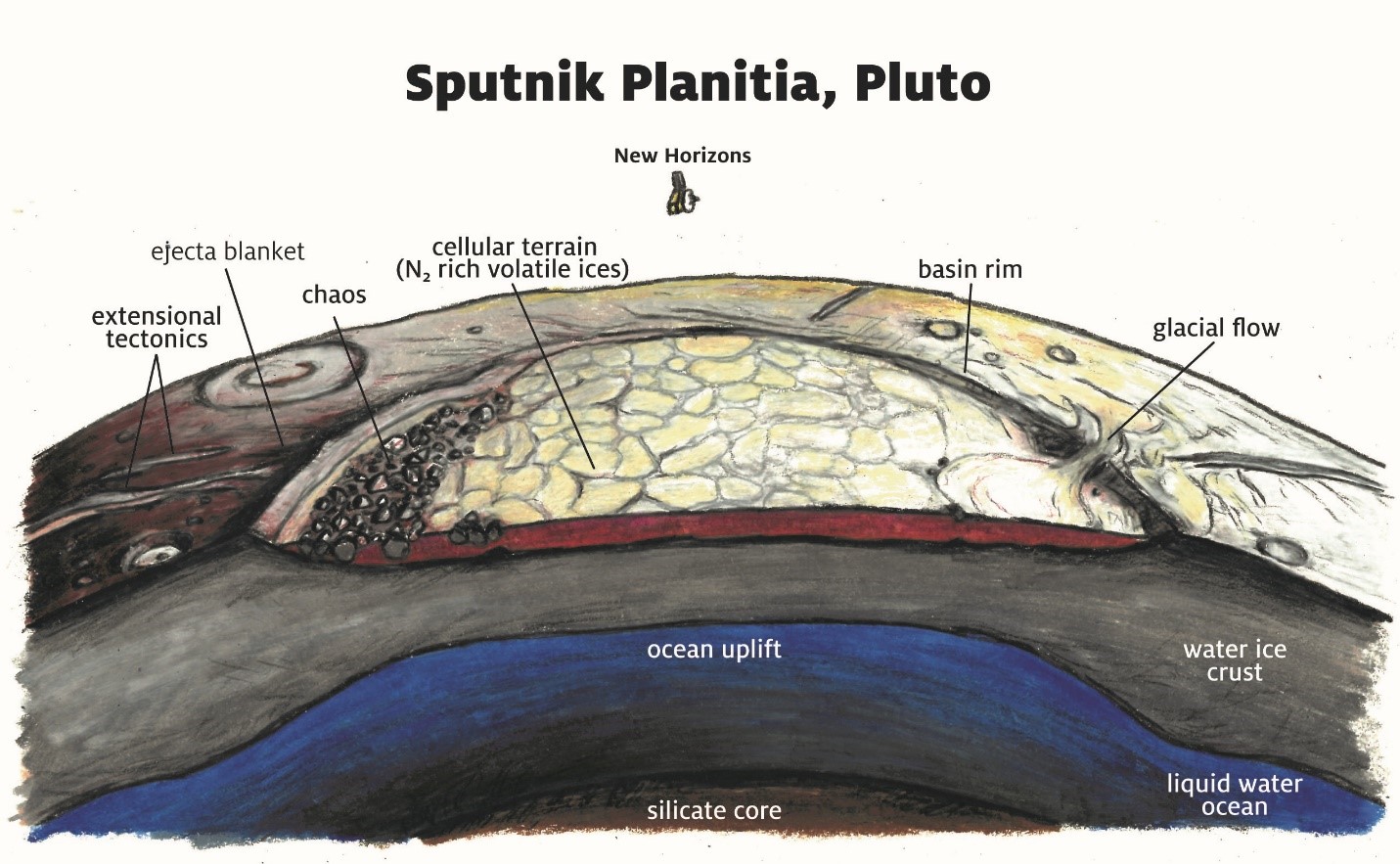
Credit: James Tuttle Keane
Enormous faults that stretch for hundreds of miles and cut roughly 2.5 miles into the icy crust covering Pluto's surface. One of the only ways scientists reason Pluto got those fissures, though, is by the gradual freezing of an ocean beneath its surface.
Water expands as it freezes, and under an icy crust, that expansion will push and crack the surface, just like an ice cube in your freezer. But if the temperature is low enough and the pressure high enough, water crystals can start to form a more compact crystal configuration and the ice will once again contract.
Models using New Horizons data showed Pluto has the conditions for that type of contraction, but it doesn't have any known geologic features that indicate that contraction has occurred. To scientists, that means the subsurface ocean is still in the process of freezing and potentially creating new faults on the surface today.
If Pluto is an active ocean world, that suggests that the Kuiper Belt may be filled with other ocean worlds among its dwarf planets, dramatically expanding the number of potentially habitable places in our solar system.
James Tuttle Keane, a planetary scientist and New Horizons team member at the Jet Propulsion Laboratory in Pasadena, California
But while Pluto's liquid ocean likely still exists today, scientists suspect it's isolated in most places (though not beneath Sputnik) by almost 200 miles (320 kilometers) of ice. That means it probably doesn't contact the surface today; but in the past, it may have oozed through volcanic activity called cryovolcanism.
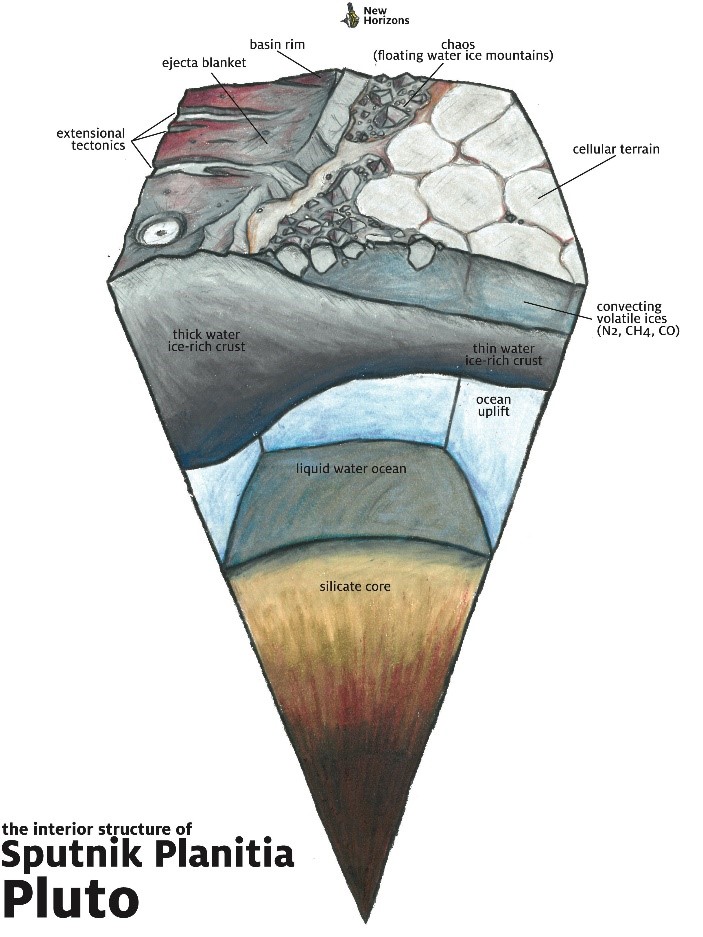
Credit: James Tuttle Keane
But maybe not "volcanic" in the way you might think.
On Earth, molten lava spits, drools, bubbles, and erupts from underwater fissures through volcanoes sitting miles high in and protruding from the oceans, like on Hawaii. But on Pluto, there are numerous indications that a kind of cold, slushy cryolava has poured over the surface at various points.
Scientists call that "cryovolcanism."
Wright Mons and Piccard Mons, two large mountains to the south of Sputnik Planitia, each bear a deep central pit that scientists believe are likely to be the mouths of cryovolcanoes unlike any others found in the solar system.
To the west of Sputnik sits Viking Terra, with its long fractures and grabens that show evidence of once-flowing cryolavas all over the surface there too.
And farther west of Sputnik Planitia is the Virgil Fossae region, where ammonia-rich cryolavas seem to have burst to the surface and coated an area of several thousand square kilometers in red-colored organic molecules no more than 1 billion years ago, if not even more recently.
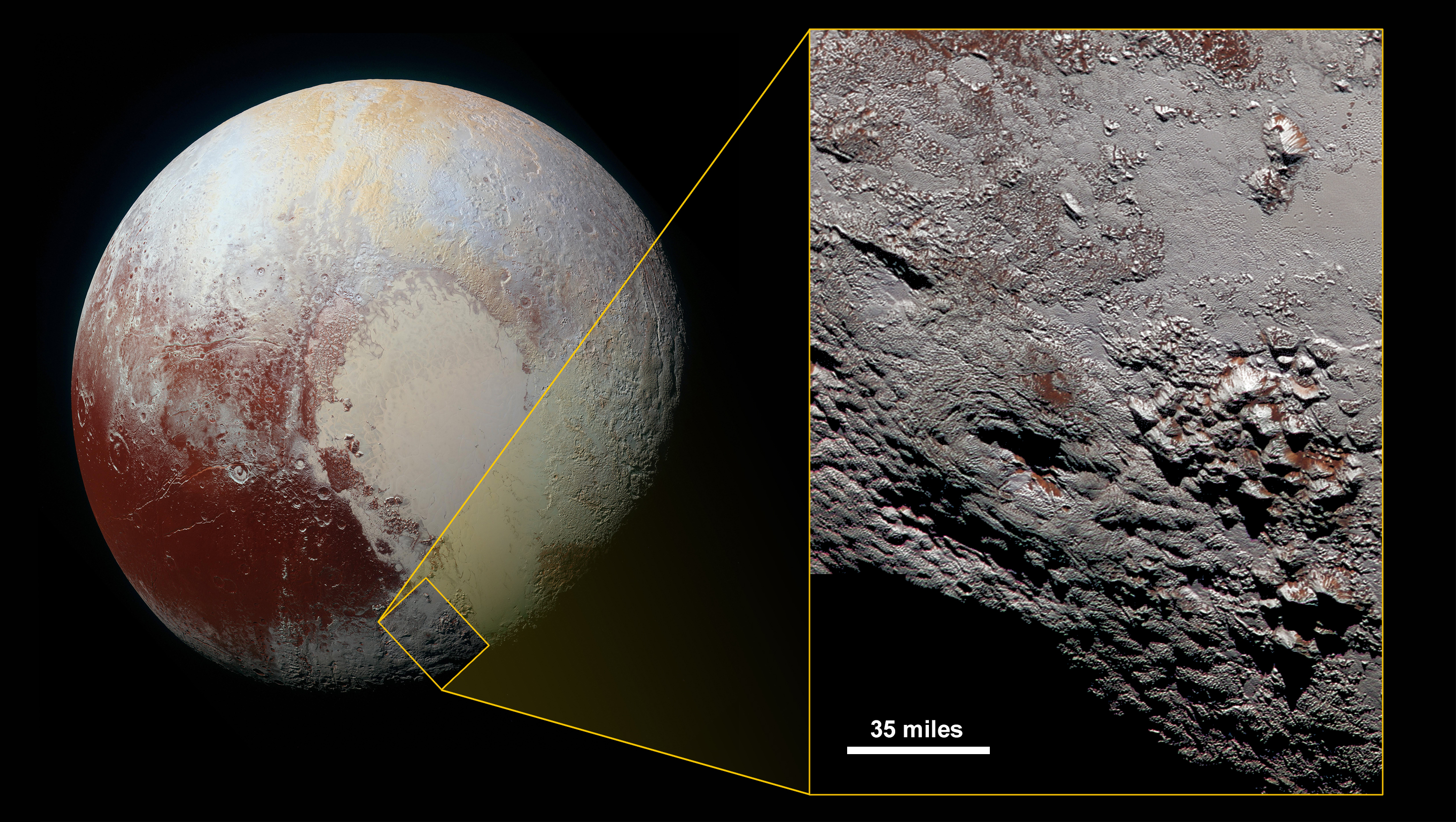
Close up view of Wright Mons, one of two potential cryovolcanoes spotted on the surface of Pluto by the passing New Horizons spacecraft in July 2015. (Credit: NASA/Johns Hopkins APL/Southwest Research Institute)
And speaking of recently...
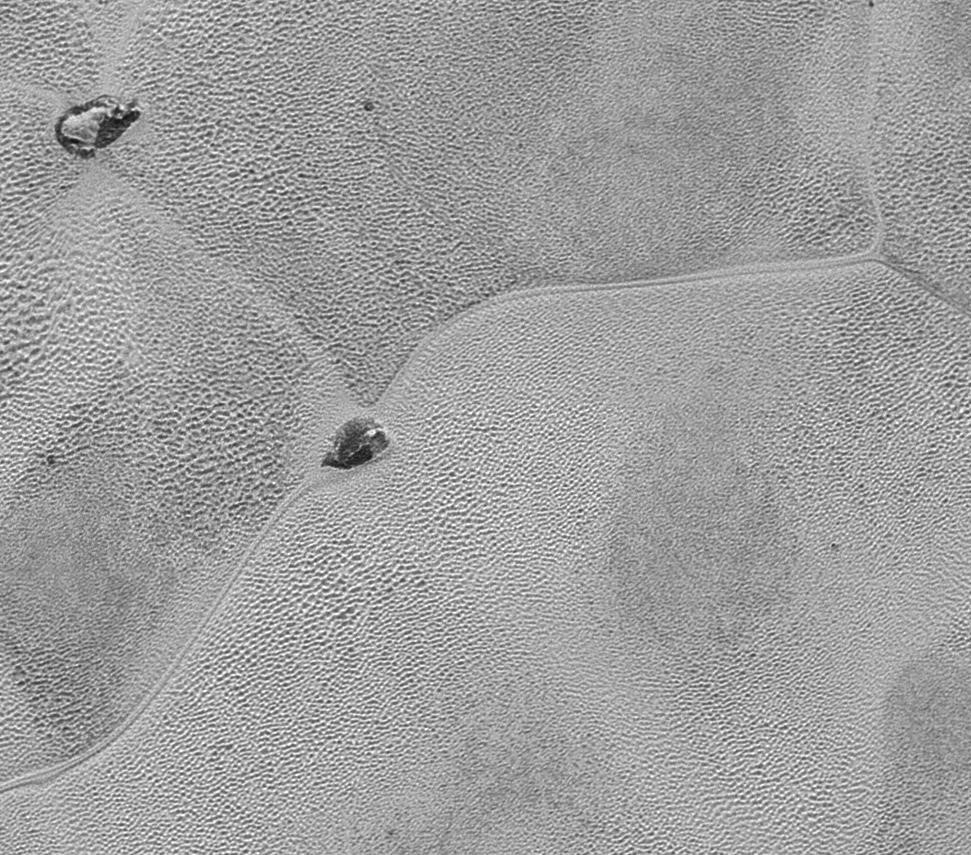
This detailed image of the glaciers in Pluto's Sputnik Planitia, about 50 miles wide, shows thousands of pits in its surface of nitrogen ice as well as larger circulation patterns. Scientists suspect the "Islands" are floating bergs of water ice, or perhaps the tips of ice mountains. (Credit: NASA/Johns Hopkins APL/Southwest Research Institute)
Pluto joins the ranks of Earth, Mars, and a handful of moons that have actively flowing glaciers.
East of Sputnik Planitia are dozens of (mostly) nitrogen-ice glaciers that course down from pitted highlands into the basin, carving out valleys as they go. Scientists suspect seasonal and "mega-seasonal" cycles of nitrogen ices that sublimate from ice to vapor, waft around the dwarf planet and then freeze back on the surface are the source of the glacier ice.
But these glaciers are not like our own water-ice glaciers here on Earth. For one, any melt within them won't fall toward the bottom of the glacier — it will rise to the top, because liquid nitrogen is less dense than solid nitrogen. As that liquid nitrogen emerges on top of the glacier, it potentially even erupts as jets or geysers.
Additionally, there is the fact that some of Pluto's surface is composed of water ice, which is slightly less dense than nitrogen ice. As Pluto's glaciers carve the surface, some of those water-ice "rocks" will rise up through the glacier and float like icebergs. Such icebergs are seen in several New Horizons images of Sputnik Planitia, the largest of Pluto's known glaciers, which stretches more than 620 miles (1,000 kilometers) across — about the size of Oklahoma and Texas combined.
Zoom in close to the surface of Sputnik Planitia and you'll see something unlike anywhere else in the solar system: a network of strange polygonal shapes in the ice, each at least 6 miles (10 kilometers) across, churning on the surface of the glacier.
Although they resemble cells under a microscope, these aren't; they're evidence of Pluto's internal heat trying to escape from underneath the glacier, and forming bubbles of upwelling and downwelling nitrogen ice, something like a hot lava lamp.
Warm ice rises up into the center of the cells while cold ice sinks along their margins. There's nothing like it in any of Earth's glaciers, and or anywhere else in the solar system that we've explored!
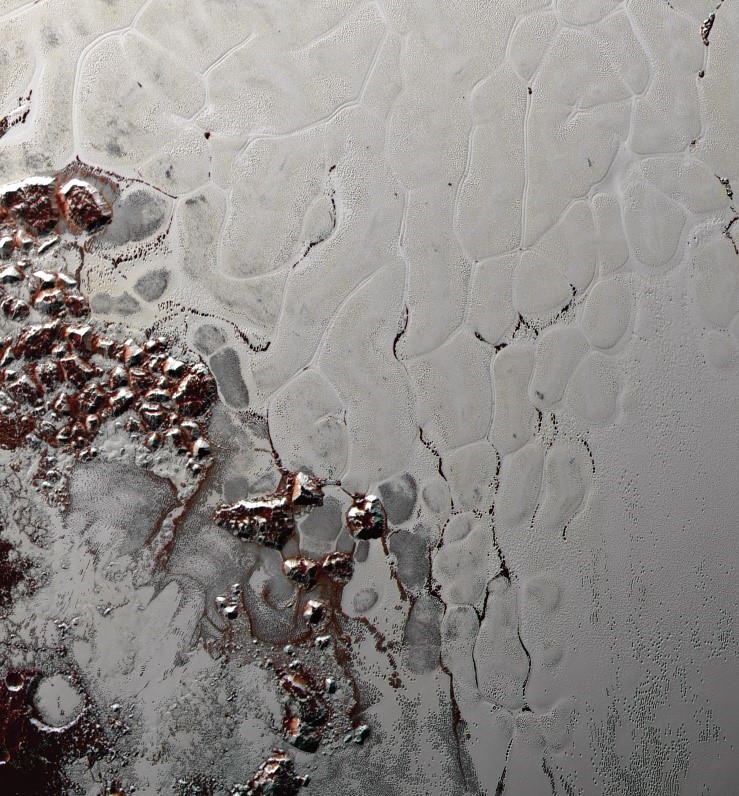
Scientists from NASA's New Horizons mission used state-of-the-art computer simulations to show that the surface of Pluto's Sputnik Planitia is covered with churning ice "cells" that are geologically young and turning over due to a process called convection. (Credit: NASA/Johns Hopkins APL/Southwest Research Institute)
Cold and far-flung as Pluto may be, its icy "heart" still beats to a daily, rhythmic drum that drives Pluto's atmosphere and climate much in the way Greenland and Antarctica help control Earth's climate.
Nitrogen ices in Pluto's heart-shaped Tombaugh Regio go through a cycle every day, subliming from ice to vapor in the daytime sunlight and condensing back on the surface during the frigid night. Each round acts like a heartbeat, driving nitrogen winds that circulate around the planet at up to 20 mph.
"Pluto's heart actually controls its atmosphere circulation," punned Tanguy Bertrand, a planetary scientist at NASA Ames Research Center in Mountain View, California.
Sophisticated weather forecast models Bertrand has created using New Horizons data show that as these ices sublime in the northern reaches of Pluto's icy heart and freeze out in the southern part, they drive brisk winds in a westward direction — curiously opposite Pluto's eastward spin.
Those westward winds, bumping up against the rugged topography at the fringes of Pluto's heart, explain why there are wind streaks on the western edge of Sputnik Planitia, a remarkable finding considering Pluto's atmosphere is only 1/100,000th that of Earth's, Bertrand said. They also explain some other surprising desert-like features...
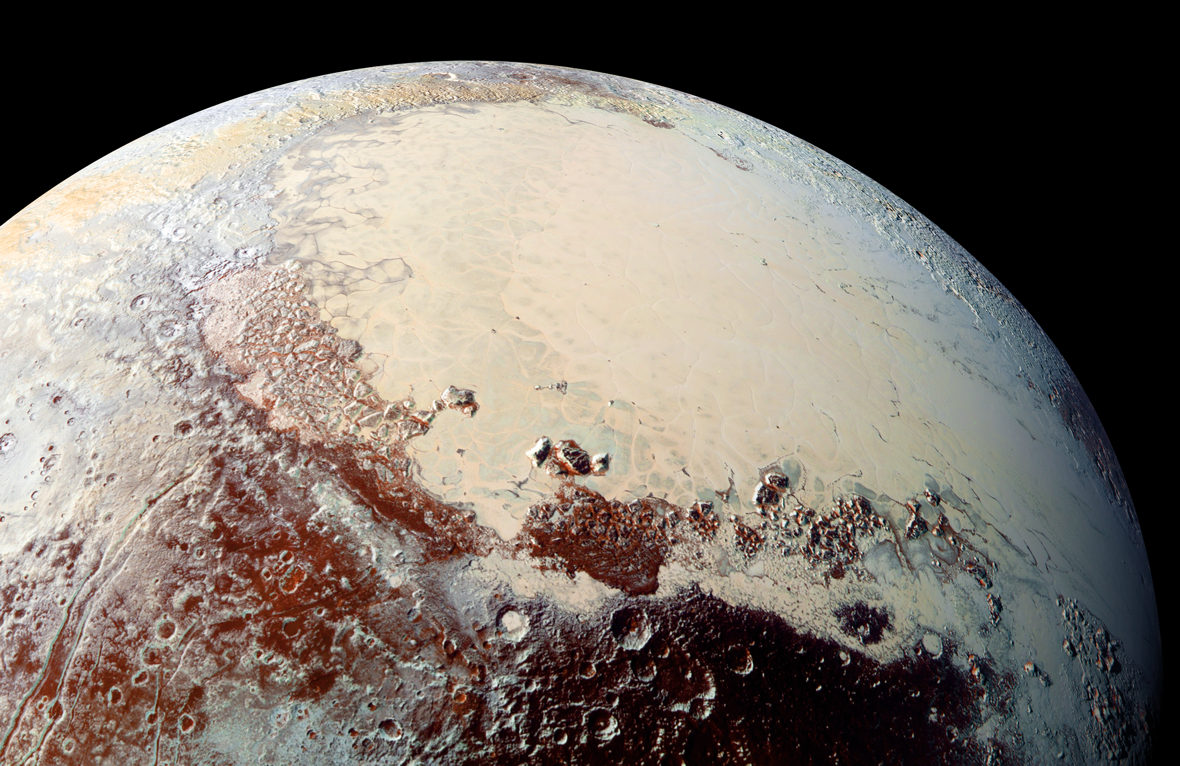
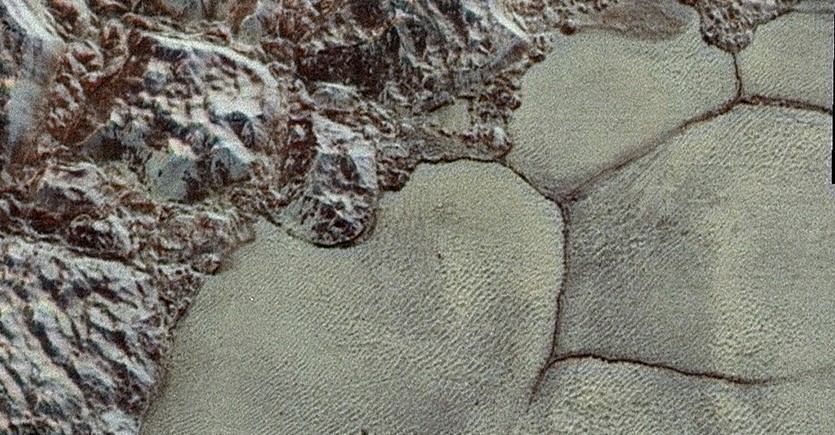
Close up of the water-ice mountains on the northwest fringes of Pluto's Sputnik glacier may provide the particles, and Pluto's beating nitrogen "heart" provides winds. (Credit: NASA/Johns Hopkins APL/Southwest Research Institute)
It's not the Sahara Desert, or the Gobi Desert. This is Pluto. Hundreds of dunes stretch over at least 45 miles (75 kilometers) of the western edge of Sputnik Planitia, and scientists suspect they formed recently.
Dunes require small particles and sustained, driving winds that can lift and blow the specks of sand or whatever else along. And despite its weak gravity, thin atmosphere, extreme cold and entire surface composition of ices, Pluto apparently had (or still may have) everything needed to make dunes.
Water-ice mountains on the northwest fringes of the Sputnik glacier may provide the particles, and Pluto's beating nitrogen "heart" provides winds. Instead of quartz, basalt and gypsum sands blown by sometimes gale-force winds on Earth, though, scientists suspect the dunes on Pluto are sand-sized grains of methane ice carried by winds that blow at no more than 20 mph, although given the size of the dunes, the winds may have been stronger and atmosphere much thicker in the past.
Finding craters on the surface of planets is kind of the norm in space. But if there's one abnormal thing about the Pluto system, it's that neither Pluto nor Charon has many small craters — they're almost all big.
"That surprised us because there were fewer small craters than we expected, which means there are also fewer small Kuiper Belt objects than we expected," said Kelsi Singer, a New Horizons deputy project scientist and coinvestigator from the Southwest Research Institute in Boulder, Colorado.
Analyses of crater images from New Horizons indicate that few objects less than about a mile in diameter bombarded either world. Because scientists have no reason to believe tectonic activity would have preferentially wiped the surface clean of these small craters, It could mean the Kuiper Belt is mostly devoid of very small objects.
"These results give us clues about how the solar system formed because they tell us about the population of building blocks of larger objects, like Pluto and even perhaps Earth" Singer said.
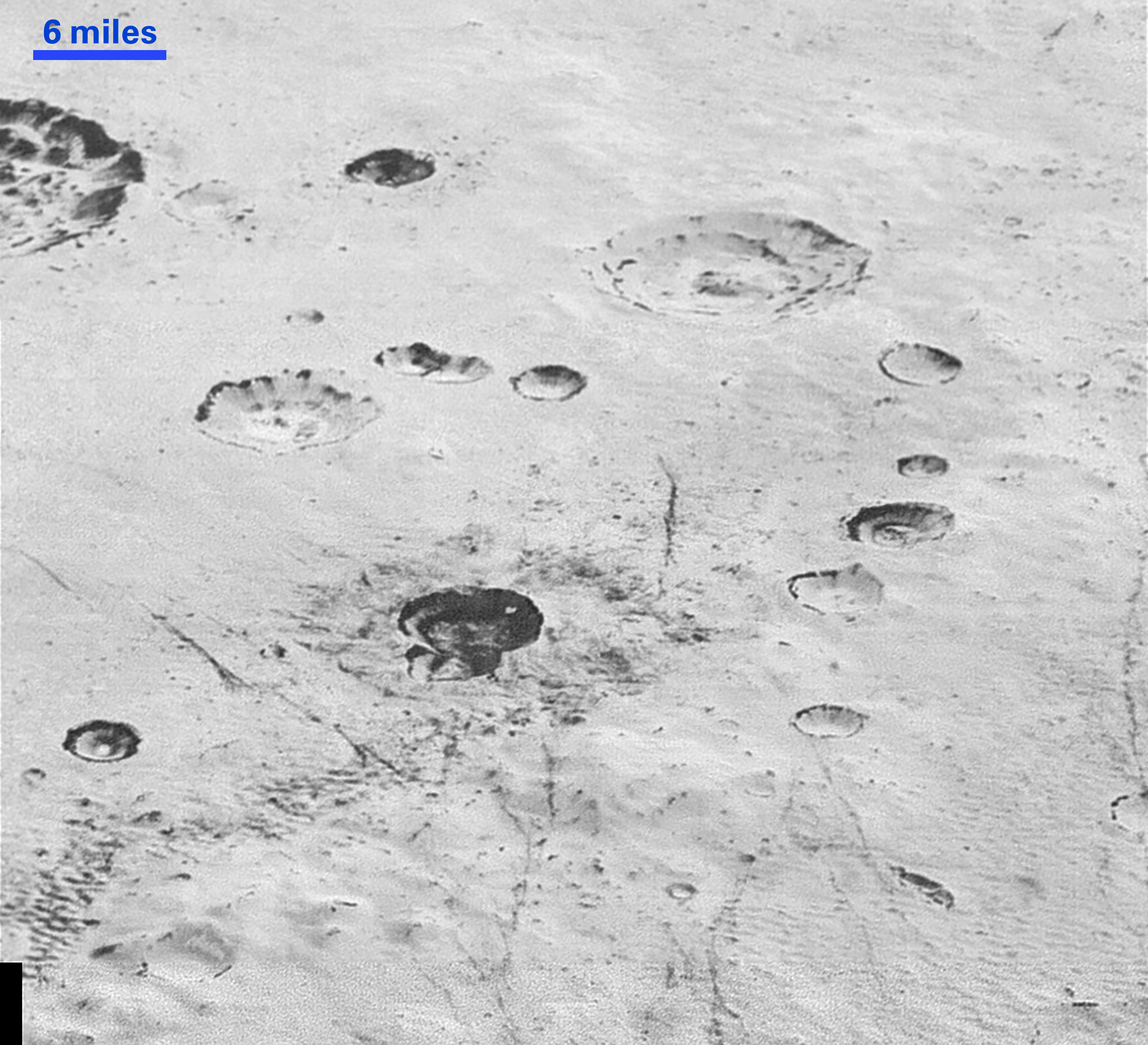
Every time we go somewhere new in the solar system, we find surprises that challenge current theories. The New Horizons flyby did just that, and in many ways!
Kelsi Singer, New Horizons deputy project scientist and coinvestigator from the Southwest Research Institute in Boulder, Colorado
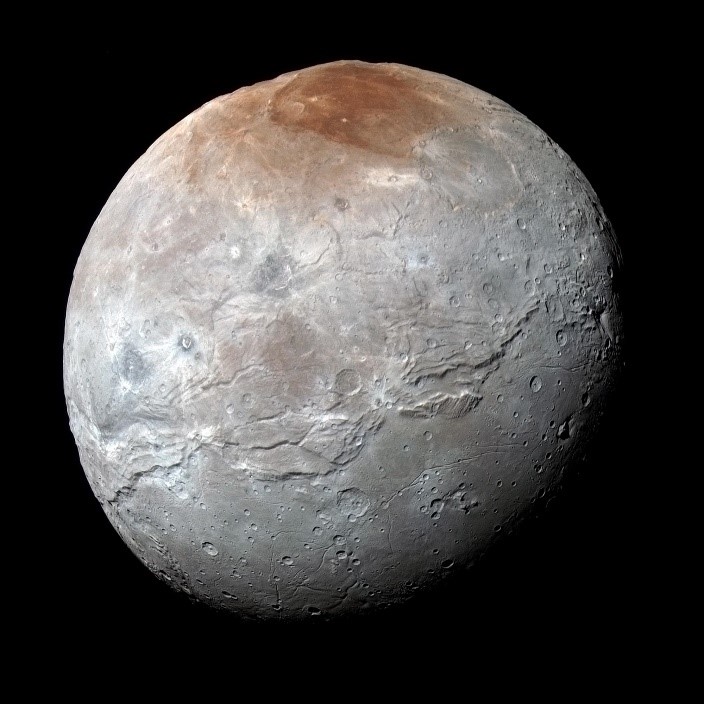
Enhanced color view of Pluto's largest moon, Charon. The colors are processed to highlight the variation of surface properties across the moon; most striking is the reddish north (top) polar region. (Credit: NASA/Johns Hopkins APL/Southwest Research Institute)
New Horizons also captured stunning images of Pluto's moon Charon, and they revealed some surprising geology there too.
On the side of Charon that New Horizons imaged in high resolution, Charon has two distinct terrain types: an immense, southward-stretching plain officially called Vulcan Planitia that's at least the size of California, and a rugged terrain colloquially called Oz Terra that stretches northward to Charon's north pole. Both seem to have formed from the freezing and expansion of (you guessed it!) an ancient ocean beneath Charon's crust.
Moderate expansion in the north created the rugged, mountains terrain of Oz Terra seen today, whereas the expansion in the south forced its way through vents, cracks and other openings as cryolava, spilling across the surface. In fact, Vulcan Planitia is thought to be a giant cryoflow that covered the entire region early in Charon's history.
Similar features exist on some icy satellites all around the solar system, including Neptune's giant moon Triton, Saturn's moons Tethys, Dione and Enceladus, and Uranus' moons Miranda and Ariel. And thanks to the detailed images of Charon from New Horizons, the models of Charon's past be a Rosetta Stone to aid in understanding the volcanic and geologic activity of those other icy worlds too.
New Horizons transformed Pluto from a fuzzy telescopic dot, into a living world with stunning diversity and surprising complexity. We were all astounded by the range of phenomena in the entire Pluto system, from Charon's polar coloring and giant chasm, to the 'iceball' makeup of the four smaller satellites that offered valuable clues to the system's origins. The Pluto encounter was exploration at its finest, a real tribute to the vision and persistence of the New Horizons team.
Quelle: NASA
+++
The PI's Perspective: July 2015 - When the Solar System Saved the Best for Last
As you read this, the New Horizons spacecraft is cruising through the Kuiper Belt, completely healthy, conducting observations of the local heliospheric and Kuiper Belt dust environment.
Last month we released the first images showing nearby stars seen in different positions than we see them from Earth. (The storied Voyagers could have made similar images, but never did.) This is caused by the parallax effect, which you can see for yourself by raising a finger at arm's length and watching it shift back and forth as you switch which eye is viewing it. Parallax shifts in star positions have been measured for centuries, but they are minute — the largest are only about 1/1000th of a degree because the stars are too far away. But at well over 4 billion miles from Earth, New Horizons now sees the nearest stars shifted by much larger amounts. As a result, our NASA spacecraft sees an alien sky we cannot see from here on Earth. Is that about the coolest nerdiest thing you've heard in a while, or what?
The principle behind the New Horizons parallax project is illustrated in the image at left. The right image shows the results, as the nearest star, Proxima Centauri, jumps back and forth against more distant stars in images made from Earth and New Horizons, over 4 billion miles away. (Credit: NASA/Johns Hopkins APL/Southwest Research Institute; graphic: Pete Marenfeld, NSF's National Optical-Infrared Astronomy Research Laboratory)
While New Horizons flies onward, our team has been cranking out new results in scientific publications about our flyby targets in the Pluto system and the Kuiper Belt object (KBO) Arrokoth. Using the giant Japanese Subaru telescope atop Mauna Kea in Hawaii, the science team is also searching for new KBOs to study in the distance or even to fly by. Meanwhile, our operations team has been guiding the spacecraft through a series of maneuvers to study these KBOs and creating software enhancements that, once we transmit them to the spacecraft next year, will give New Horizons some impressive new scientific capabilities.
All is well, and very busy, for the mission team.
A Fantastic Flyby
I want to take the opportunity of mid-July 2020 to focus for a minute on mid-July in 2015, when our team and our bird made the first exploration of Pluto, the farthest planet known at the dawn of the space age. And what an absolutely amazing set of worlds Pluto and its five moons turned out to be!
As the title of this blog says, I think the solar system literally saved the best for last with Pluto. Of course, I'm a little biased -- as we all are on New Horizons -- but I can't think of a more beautiful and scientifically richer way to have completed the first era of the reconnaissance of the planets, which NASA started in 1962 with the first visit to any planet – Venus.
My strongest memories of that week are of our team's many years of hard work paying off, and of the excitement I saw in every single team member as the first detailed images of Pluto and its largest moon, Charon, came to Earth.
New Horizons team members, gathered at the Johns Hopkins Applied Physics Laboratory in Laurel, Maryland, react to seeing Pluto close up for the very first time, on the morning of July 14, 2015. (Image credits: NASA/Johns Hopkins APL/Southwest Research Institute; top left: Michael Soluri)
It took 16 months to transmit all the Pluto system data back, but by late 2016, the entire haul of precious data was here on Earth. Now, after five years of work to analyze those data, our appreciation and understanding of Pluto and its moons just continues to multiply. More than 100 refereed scientific papers have been published, and a 1,000-plus-page scientific review compendium, largely by authors on the New Horizons team, summarizing basic results and interpretations of data from the Pluto flyby, is nearing publication too.

The binary planet system Pluto-Charon, first seen up close by New Horizons. (NASA/Johns Hopkins APL/Southwest Research Institute)
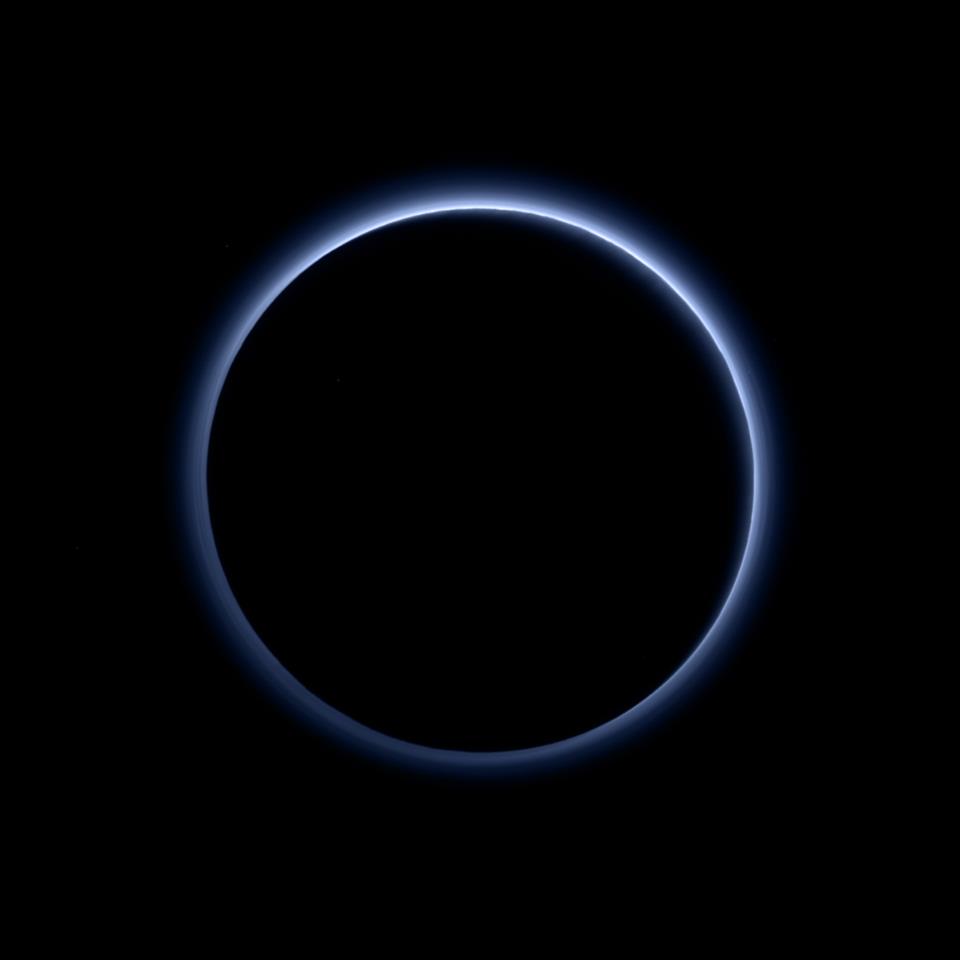
Pluto as seen on departure by New Horizons, backlit by the Sun. (Credit: NASA/Johns Hopkins APL/Southwest Research Institute)
And, not surprisingly, the results keep pouring in as more detailed analysis and computer modeling teach us more and more about Pluto itself, specifically its geology, chemistry, atmosphere, moons and origin.
Going back to just before the flyby, who could have predicted that not one but all of the following (and more!) would be discovered?
- Four separate lines of evidence pointing to a liquid water ocean inside Pluto.
- Forensic evidence in an apparently frozen lake that Pluto's atmosphere waxes and wanes, and is sometimes thicker than the atmosphere of Mars.
- The discovery of the largest glacier in the solar system, spanning an area larger than Texas and Oklahoma combined – and that this glacier roils in thermally driven convective motion.
- Images indicating at least two different kinds of cryovolcanism on Pluto, one or maybe both of which may have extruded organics from Pluto's subsurface water ocean.
- Clues in Charon's dark red northern polar cap that some of Pluto's atmospheric methane escapes and becomes trapped onto the moon.
- Areas on Pluto's surface almost as old as our 4.5 billion year old solar system, to terrains 10,000 times younger, born perhaps no more than hundreds of thousands of years ago.
- And a sci-fi-like assortment of methane snowcapped mountains, giant canyon systems, strangely aligned, bladed mountain ranges, ground fogs, and layered atmospheric hazes in Pluto's blue sky.
And those are just the tip of the iceberg of discoveries made at Pluto! Any one of these alone would have been worth the journey. But discovering them all? No Christmas or Hanukkah could have brought better presents than this!
It's hard to believe that was five years ago; the time since has literally flown by to me. And these results have been so impactful in the field of planetary science that missions are being studied in preparation for the new Planetary Decadal Survey to go back to Pluto and the Kuiper Belt with even more powerful sensors aboard a Pluto orbiter. By the time we mark the 10th anniversary of the Pluto flyby in July 2025, such a mission could even be under construction.
Meanwhile our exploration of the Kuiper Belt and KBOs with New Horizons is far from complete. Next time, I'll give an update on the results of those telescopic searches we're making for new KBO targets for New Horizons.
With that, I'll conclude this report. In the meantime, I hope you'll keep on exploring — just as we do!
–Alan Stern
There are many ways to follow New Horizons news and commentary on social media! You can find others by searching on the Web.
Quelle: NASA

